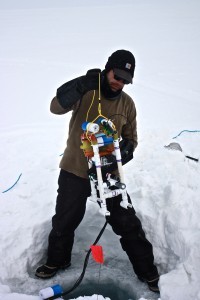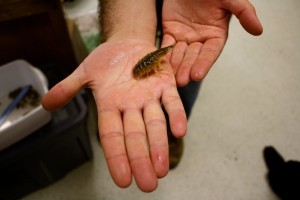Science, Creativity and Isopods
It’s near midnight and Lamont-Doherty Earth Observatory researchers Andy Juhl and Craig Aumack, and Arizona State’s Kyle Kinzler are gathered around a table in their lab at the Barrow Arctic Research Consortium discussing the best way to catch an isopod.
It’s near midnight and Lamont-Doherty Earth Observatory researchers Andy Juhl and Craig Aumack, and Arizona State’s Kyle Kinzler are gathered around a table in their lab at the Barrow Arctic Research Consortium discussing the best way to catch an isopod. When scientists do fieldwork, they enter into it with specific questions and science goals in mind, but one of the joys of exploring the world through scientific research is solving challenges and devising new ways to collect data.

Meet Brinson. He’s a remotely operated vehicle (ROV) along on our Arctic expedition and named in honor of a foundation that provided Andy funding to build him. Brinson, originally designed and built by engineer Bob Martin, and modified by Andy, is the result of an idea that evolved over several years of Arctic fieldwork.
“We were deploying just this ice fishing camera, but were frustrated by the fact that there was always something just beyond our range that we wanted to see,” said Andy. “So we wanted mobility and once we got that we were frustrated by the fact that we didn’t know how big things were, and that’s when we decided we needed the laser pointers to provide scale. So Brinson has been a multi-step evolution into a simple, but well-equipped ROV.”
Brinson now consists of a GoPro camera and a standard ice fishing camera attached to a frame made of PVC pipe that can be lowered into a hole in the ice. On the ice surface, the ice fishing camera’s live video feed shows what Brinson sees as he travels through the water. Brinson is equipped with small bilge pumps that act as motors, which enable him to be maneuvered forward, up, down and side to side via his tethered remote control. When Brinson is below the ice, Craig monitors the video feed and describes to Andy what he sees on the screen. When something of interest appears, Craig tells Andy which way to maneuver Brinson, so they can continue to get footage of the organism.
Brinson recently saw small crustaceans called isopods roaming around the ocean floor. Andy and Craig were excited about this find and very curious to learn more about what isopods might eat and their role may be in Arctic the marine food web. Once Brinson, and Andy and Craig, saw the isopods, it was decided that our team should catch some, but we had no trap or means of doing so.
Scientists need to bring absolutely everything they need, and think they might need, with them on research expeditions, especially those to remote areas like Alaska’s North Slope. So, when, for example, you decide you must build an isopod trap late at night in Barrow, you’re pretty much limited to what you have on hand: a plastic buckets, plastic window screening, electrical tape, rocks, string.

With these materials, a little ingenuity and their limited knowledge of isopod behavior, Craig and Kyle constructed isopod traps. The guys hypothesized that isopods might like chicken, so baited their traps with chicken bones saved from our dinner. The traps were attached to eight meters of string and dropped to the sea floor. Kyle’s trap sat overnight and caught two isopods; Craig’s trap sat on the ocean bottom for several days and contained at least 20 isopods when it was pulled up.
The beauty of the isopod traps is that they worked and project scientists will get valuable data about the Arctic marine food web as a result. “From the underwater videos shot by Brinson, it looks like the activity of the isopods increases after the ice algae exports,” Andy explained. “We think there’s a plausible connection there: the ice algae could be a food source for isopods. We never would have posed that as a hypothesis unless we had the opportunity to observe them and make these connections.”
Fieldwork is, in part, a pattern of observing and questioning, and responding to these with new theories, methods and experiments. It’s also part of a larger creative process that involves improvisation and unconventional thinking. Said Andy, “In the field, we make a lot of stuff out of duct tape and epoxy.”
For more information on this research project, visit http://lifeintheice.wordpress.com or follow Lamont-Doherty Earth Observatory and the hashtag #LDEOarctic on Twitter.
